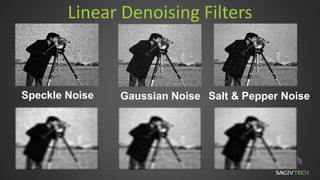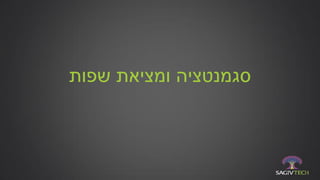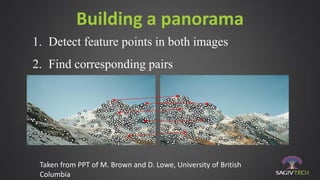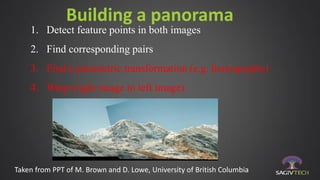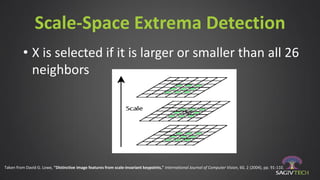Introduction talk to Computer Vision
- 1. ממוחשבת לראיה מבוא שגיב חן ומנכ מייסדת"בע שגיבטק משותפת לית"מ
- 2. ההרצאה תוכן •ממוחשבת ראיה–טוב זה ולמה זה מה? •בסיסיים דברים כמה •ממוחשבת ראיה של קלסיקה •ה מהפיכת-AI •הממוחשבת הראיה לעולם כניסה
- 3. ממוחשבת ראיה מהי? •כלים בעזרת מתמונות מידע והוצאת שיפור ממוחשב ועיבוד מתמטיים •מטרות: –האנושי לצופה התמונה של מיטבית הצגה –מידע והפקת תמונות של ממוחשבת אנליזה
- 4. ממוחשבת בראיה משתמשים היכן? •רפואה •אוטונומיים רכבים •רבודה ומציאות מדומה מציאות •תעשיה:פגמים איבחון •חברתיות רשתות •בטחונית תעשיה,אבטחה ואכיפתחוק •חקלאות •וטיפוח אופנה Taken from: http://www.cvl.isy.liu.se/
- 6. דיגיטלית תמונה נוצרת איך? •ה"אופטיקה"-הגל לאורך שרגיש סנסור ידי על תמונה רכישת המתאים:נראה אור,US,אינפרא-אדום •שהתקבלה לאנרגיה פרופורציונלי חשמלי אות מייצר הסנסור •האנלוגי האות דגימת •DSP-בצבע טיפול,שגויים פיקסלים,רעש
- 7. דיגיטלית תמונה נוצרת איך?
- 8. האנושית הראיה מערכת מ לקוח-Wikipedia
- 9. מרחבית דגימה Taken from Digital Image Processing, Gonzalez
- 10. נייקוויסט ותדר הדגימה משפט •דגום אות לשחזר כדי כי קובע זה משפט,קצב האות מתדר כפליים לפחות להיות צריך הדגימה הדגום.נקרא זה דגימה קצב:נייקויסט תדר
- 11. צריך אפור רמות כמה? •ב משתמשים הצגה לצרכי-8ביט •לצרכיבנות בתמונות מטפלים תמונה ניתוח10- 12יותר ואף ביט
- 12. Taken from Digital Image Processing, Gonzalez
- 14. Linear Denoising Filters Speckle Noise Gaussian Noise Salt & Pepper Noise
- 15. Median Filter Speckle Noise Gaussian Noise Salt & Pepper Noise
- 17. סגמנטציה מבוססת מה על? •אזורים בין מעבר יש בהן נקודות או השפה חיפוש– שפות מבוססות שיטות •שבו שהפיקסלים אזור הגדרת"דומים"לזה זה– אזורים מבוססות שיטות
- 18. Gray-level profile First derivative Second derivative
- 21. Global Processing: The Hough Transform •ע לתיאור ניתן בתמונה ישר כל"משוואה י. •קווים אינסוף לעבור יכולים הישר על נקודה כל דרך •בהתמרתHoughנקודה כל"מצביעה"הקווים עבור דרכה לעבור שיכולים •קולות הרבה הכי עם הישר-מנצח!
- 25. A motivating application Building a panorama • We need to match/align/register images Taken from PPT of M. Brown and D. Lowe, University of British Columbia
- 26. Building a panorama 1) Detect feature points in both images Taken from PPT of M. Brown and D. Lowe, University of British Columbia
- 27. Building a panorama 1. Detect feature points in both images 2. Find corresponding pairs Taken from PPT of M. Brown and D. Lowe, University of British Columbia
- 28. Building a panorama 1. Detect feature points in both images 2. Find corresponding pairs 3. Find a parametric transformation (e.g. homography) 4. Warp (right image to left image) Taken from PPT of M. Brown and D. Lowe, University of British Columbia
- 29. Scale-Space , , , , ,L x y G x y I x y 2 2 2 2 2 1 , , 2 x y G x y e
- 30. DoG http://www.cs.ubc.ca/~lowe/papers/ijcv04.pdf Taken from David G. Lowe, "Distinctive image features from scale-invariant keypoints," International Journal of Computer Vision, 60, 2 (2004), pp. 91-110.
- 31. Scale-Space Extrema Detection • X is selected if it is larger or smaller than all 26 neighbors Taken from David G. Lowe, "Distinctive image features from scale-invariant keypoints," International Journal of Computer Vision, 60, 2 (2004), pp. 91-110.
- 32. Keypoint Localization Threshold on minimal contrast Threshold on ratio of principal curvatures Taken from David G. Lowe, "Distinctive image features from scale-invariant keypoints," International Journal of Computer Vision, 60, 2 (2004), pp. 91-110.
- 33. Orientation assignment • Create weighted histogram of local gradient directions computed at selected scale • Assign canonical orientation at peak of smoothed histogram • For location of multiple peaks multiply key point Taken from David G. Lowe, "Distinctive image features from scale-invariant keypoints," International Journal of Computer Vision, 60, 2 (2004), pp. 91-110.
- 34. Keypoint descriptor https://www.youtube.com/watch?v=FsFC8sCpDSw Taken from David G. Lowe, "Distinctive image features from scale-invariant keypoints," International Journal of Computer Vision, 60, 2 (2004), pp. 91-110.
- 35. • If you’ve been to a concert recently, you’ve probably seen how many people take videos of the event with mobile phone cameras • Each user has only one video – taken from one angle and location and of only moderate quality Mobile Crowdsourcing Video Scene Reconstruction
- 36. Creation of the 3D Video Sequence The scene is photographed by several people using their cell phone camera The video data is transmitted via the cellular network to a High Performance Computing server. Following time synchronization, resolution normalization and spatial registration, the several videos are merged into a 3-D video cube. TIME
- 38. Feature detection + Matching Fundamental matrix estimation Global registration
- 39. Time & Audio Synchronization
- 40. • Precise : epipolar matching is both fast and accurate • Dense multi-scale description of the images using binary descriptors 3D Model Reconstruction
- 41. • Precise : epipolar matching is both fast and accurate • Empirical probability density check to discard false positives at occlusion points Correct match : max peak above other local max Wrong match : max peak similar to other local max 3D Model Reconstruction
- 42. • Robust : works even with a minimal set of inputs • two viewpoints already sufficient for dense reconstruction • very few erroneous points 3Dreconstruction 3D Model Reconstruction
- 43. 3D Visualizer for Dynamic Scenes moving unknown
- 44. המחשב מן האדם מותר? Kanizsa
- 45. ה מהפיכת-AI
- 46. • Image classification revolutionized by DL – ImageNet – from 27% to ~5% in three years What happened in ImageNet 2012 ?
- 47. • In this case, our classifier would have a decision boundary more complex than the simple straight line. • All the training patterns would be separated perfectly. Learning Methods - Supervised
- 48. • Simpler recognizer better performance on novel patterns. • This is one of the central problems in statistical pattern recognition. Learning Methods - Supervised
- 49. • Feature extraction Discriminative features Invariant features with respect to translation, rotation and scale. • Classification Use a feature vector provided by a feature extractor to assign the object to a category Learning Methods - Supervised
- 50. • A multi layered Neural Network (NN) – With non linearity • The input to the DL NN is presented at the input layer – Images, sound, laguage... • Hidden layers extracts increasingly abstract features • Output layer contains the result Neural Networks
- 51. • More complex neural networks with multiple layers and multiple output neurons are theoretically capable of separation using any continuous surface. • The straight line depicts the separation achieved by a simple Perceptron and the curve the separation by a multi-layered network (left), which is in theory able to learn any separating function. Learning methods Supervised
- 52. What can you do with Machine & Deep Learning ? • Train classifiers for specific recognition tasks • Localization – fully convolutional connected networks – train networks, e.g. RCNN, YOLO
- 53. The task: What object category do we see in the image? Benchmark: 1000 category “ImageNet” dataset. (from Alex Krizhevsky, Ilya Sutskever, Geoffrey E. Hinton, ImageNet Classification with Deep Convolutional Neural Networks, NIPS, 2012.) Image Classification
- 54. 2012 AlexNet results were what jump started the current neural network wave. Current results (networks with tens/hundreds of layers) perform better than humans on this task! Image Classification - continued
- 55. Task: Find bounding boxes and categories of objects in the image. Benchmark: PASCAL VOC / Microsoft COCO In right video: YOLO 2 (You Look Only Once) Object Detection https://www.youtube.com/watch?v=VOC3huqHrssg
- 56. Task: Assign each image pixel a category label (person, wall, road, dog, ..) Example Dataset: PASCAL VOC2012 Challenge SegModel, Deep-Labv2, and many more.. Image Semantic Segmentation
- 57. Task: Given an image and a question, answer the question. Question Answering
- 58. Task: Given a dataset of images, generate new artificial image that look real! State of the art: Generative Adversarial Networks (GANs) Image Generation
- 59. Steering the wheels of self driving cars Super resolution Image completion Saliency detection Human pose detection Facial keypoints (nose, eye, ear..) Image captioning Activity recognition And many, many more tasks ….
- 60. SagivTech Traffic Lights Detection using DL With dlib & a few images from Google street view https://www.youtube.com/watch?v=jg444J2AmOI https://www.youtube.com/watch?v=YV4y1iqo_TQ
- 61. What can you do to get into this world ? • Theory: – Get to know basic computer vision and some “classical” algorithms, e.g. Viola Jones, SIFT, etc. – Get to know Deep Learning, e.g. CS 231 by Stanford • Practice: – Get to know and use OpenCV – Hands on experience with Caffe, Tensor Flow etc.
- 62. Technology and Professional Services company Established in 2009 and headquartered in Israel SagivTech Snapshot • What we do: • Technological Solutions • Projects • Research • Core domains: • Computer Vision • Deep Learning • Code Optimization • GPU Computing
- 64. Thanks for the following SagivTech team members and collaborators: Acknowledgements • Prof. Peter Maass, University of Bremen • Prof. Pierre Vandergheynst, EPFL • Dov Eilot, SagivTech • Jacob Gildenblat, SagivTech • Amir Egozi, SceneNet project
- 65. Thank You F o r m o r e i n f o r m a t i o n p l e a s e c o n t a c t C h e n S a g i v c h e n @ s a g i v t e c h . c o m + 9 7 2 5 4 7 7 0 6 0 8 9













